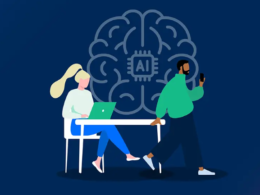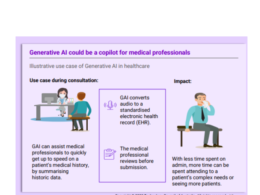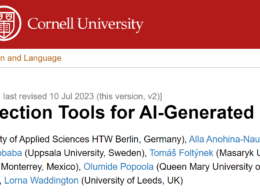the health strategist
institute for strategic health transformation
& digital technology
Joaquim Cardoso MSc.
Chief Research and Strategy Officer (CRSO),
Chief Editor and Senior Advisor
September 29, 2023
One page summary
What is the message?
Generative AI is revolutionizing the software industry, raising questions about how software companies can maintain their competitive edge.
This article explores the disruptive potential of generative AI and offers guidance on how software companies can integrate generative AI functionality to stay ahead in a rapidly evolving market.

Key Takeaways:
1. Disruptive Potential of Generative AI
- Generative AI is set to disrupt the software industry, impacting different layers of the technology stack.
- Foundational technologies like data repositories, data plumbing, and cloud services are less likely to be disrupted as they control data flows.
- However, generative AI can erode ancillary competitive advantages such as UI/UX and integration capabilities.
- Operational tooling and cybersecurity may face increased competition due to lower entry barriers.
- Productivity apps and low code/no code platforms are at risk as generative AI can automate tasks and code generation.
- Communication-based apps are less likely to be disrupted, while workflow tools and creative tools may face challenges.
2. The Criticality of Adding Generative AI Functionality
- The urgency to integrate generative AI functionality depends on the disruption risk in each software layer.
- Apps face the highest disruption risk and should add generative AI features to stay competitive.
- Customers are willing to pay for enhancements like natural language interfaces and AI-generated content.
- Companies in middle-tier categories should consider adding generative AI functionality to meet customer expectations.
- Some areas, like data backup and virtualization, may benefit less from immediate integration, but companies should monitor industry developments.
3. Taking Action in a Rapidly Evolving Space
- Software companies must react urgently to retain and evolve their competitive advantage in the generative AI era.
- Early adoption of generative AI can make a product invaluable and ubiquitous.
- Examples of companies, such as Notion, Slack, ServiceNow, and Canva, adding generative AI functionality demonstrate the market’s potential.
Statistics:
- Notion’s rumored $100 million annual recurring revenue (ARR) increase after adding generative AI functionality.
- Salesforce introducing Einstein GPT to create custom AI-generated content based on customer data.
- Hyperscalers like Google offering tools to help developers access foundational models and create customized solutions.
Examples:
- Slack launching a ChatGPT-like app to create conversation summaries and assist in writing.
- ServiceNow integrating automated workflow generation into its toolkit.
- Canva providing image generation from text prompts.
In conclusion:
Generative AI is reshaping the software landscape, and software companies must act strategically to maintain their competitive advantage.
By assessing their position in the tech stack and embracing generative AI functionality, companies can adapt to the evolving market and deliver greater value to their customers.
Infographic


DEEP DIVE

Sustaining competitive advantage in software in the world of Generative AI
Akash Bhatia, Naila Dharani, and Nipun Misra
April 21, 2023

“Software is eating the world, but AI will eat software.” This has been a maxim in the tech sector for several years but has never felt truer than it does now with the rise of generative AI. All of a sudden, AI is helping everyone be more productive, with tools to brainstorm new designs, summarize documents, write code, and so much more.
For software executives, existential questions such as “Will it be easier for competitors to enter my space now?” or “If I’m known for my UI/UX, can that still be my core value proposition?” and “What is the value of a low/no code platform now?” became top of mind.
We don’t have a crystal ball, but based on how the market is evolving, we’ll aim to answer two fundamental questions:
1. Will generative AI disrupt my enterprise software (SW) business?
2. What do I need to do to retain competitive advantage?
The Disruptive Potential of Generative AI
Whenever there is a new “foundational” technology, we can be sure there will be a new set of winners and losers. While that’s no different with generative AI, each layer of the tech stack will be impacted differently based on its source of competitive advantage and value proposition to customers (see Exhibit 1).

Let’s go from darkest to lightest, or what’s least likely to most likely to be disrupted. What’s most surprising about this view is that the traditional recommendation of moving up the stack may no longer be the best advice. The companies that store and create systems of record (enterprise resource planning (ERP), customer relationship management (CRM), data repositories), provide data plumbing and infrastructure (virtualization, data services, data backup and protection), and underlying compute power (cloud services) are the least likely to have their competitive advantage disrupted (cloud services will likely see a boost in business from the compute power needed to run the increased number of models). While generative AI has the ability to create new data, being the source of truth or the tools to control data flows will continue to be critical.
That said, while the core functionality of these products may not be disrupted, some of their value proposition may be impacted. For example, a CRM system’s competitive advantage is primarily from being the single source of truth for customer data. That won’t change with generative AI. However, other aspects of the value proposition such as apps that sit on top of the data, the simplicity of their UI/UX, and their ability to connect to the other programs within a customer’s tech stack may not be so lucky. With the ability to generate new UIs on the fly, the ease of automating tasks, and the ability to integrate functionality into other products, generative AI has the power to erode some of the ancillary competitive advantage.
If we move to the lighter blue areas of the stack on operational tooling and cybersecurity, there is potential for increased competition and pricing pressure due to lower barriers to entry. Generative AI has the ability to easily create synthetic data, identify patterns, build and suggest models, run tests, and recommend solutions. A lot of these are fundamental building blocks for a cybersecurity monitoring solution, and they no longer require proprietary data sets or models to be commercially ready. The story is similar in operational tooling: the ability to recognize data patterns and create and suggest predictive models can be game changing for new ML Ops and Observability solutions. For DevOps, our view is slightly more nuanced: there’s a potential to significantly automate orchestration software, but the value in code databases such as GitHub is high because they can start to autogenerate code. The actual disruption risk depends on the specific tool. Further, there may be a new set of DevOps tools needed to support developers enhancing foundation models.
We expect the greatest impact in the (lightest blue) app layer. Apps that are based on communications and network effects (e.g., LinkedIn, Zoom, Slack, Dropbox) are less likely to be disrupted — the core value of file-sharing platforms such as Dropbox isn’t being able to store data in the cloud, but rather its ability to connect and share files across devices — and that connection and network cannot be automated or taken away by generative AI.
But as we move to productivity apps, the disruption risk is greater. The need for a business intelligence (BI) tool to visualize data may decrease if someone can auto generate a dashboard for a specific data cut based on a natural language query. Similarly for low code/no code platforms, since generative AI can auto generate the actual code itself, the value in the intermediary platform and UI/UX for non-developers is potentially less important. But there is also some good news: we don’t expect productivity apps to face “full disruption” if they add gen AI functionality to their product, as Microsoft is doing with Office 365.
Workflow tools are potentially more at risk, as the value from workflows may be reduced by generative AI’s ease of automation, ability to connect data, and responsiveness to queries. The tools we think are potentially most at risk are true “creative” tools that have functionality to easily create visual content and an easy-to-use UI/UX. In a world where you can just type a query into an image generator and have a brochure appear instantly, this creative tooling may not be as valuable.
Despite this potential disruption risk across the stack, the key takeaway shouldn’t be panic. Instead, SW companies can add to their value proposition and competitive advantage by integrating generative AI into their product suite.
The Criticality of Adding Generative AI Functionality
While all SW companies should revisit their roadmaps given this new technological step change, depending on the layer in the stack and the type of functionality they offer, some SW companies have more of an urgent imperative to add gen AI features than others (see Exhibit 2).

Unsurprisingly, for most of the parts of the tech stack, the higher the disruption risk the more critical adding gen AI functionality to the product suite is. Apps face the highest disruption risk, and customers expect these tools to have new features (e.g., tools such as Tableau will be expected to add a natural language interface for real-time dashboard and analysis generation).
And customers are willing to pay for these enhancements. For example, Notion added generative AI functionality such as writing, summarizing, and brainstorming — and because of its add-on pricing model, has seen a rumored $100 million (ARR) increase in just one month.
In the last few months, other app companies have followed suit: Slack has launched a ChatGPT-like app to help users create conversation summaries and assist in writing; ServiceNow is building automated workflow generation into its toolkit; and Canva is providing image generation from text prompts.
That said, given the hype around generative AI with users, many companies are “leading with marketing” or announcing plug ins with ChatGPT to stay relevant with customers but are still building out their updated roadmaps.
Moving to the substantial portions of the stack that fall in the middle category of criticality, companies in these areas should add gen AI functionality, but it’s not an existential risk if they don’t — at least not yet. Cybersecurity organizations will all of a sudden have to protect against new and more powerful adversaries; they will need to build in generative AI-based defense systems and will likely find themselves in a continuously escalating cyber-race. Knowing that its customers expect generative AI functionality on top of the company’s underlying customer data system of record, Salesforce has introduced Einstein GPT, which can create custom, AI-generated content based on the customer data already in the platform. Similarly, the hyperscalers (e.g., Google with Vertex AI and App Builder) are building tools to help developers access foundational models and create customized solutions and applications. We expect companies that provide DevOps, Observability, and ML Ops solutions to similarly add generative AI functionality to enhance the user experience and meet customer expectations.
For a few areas such as data backup and protection or virtualization, the value of adding generative AI functionality at this stage is less clear. That’s not to say these companies should sit on their laurels — we encourage them to take a watchful eye to see how the industry evolves and identify the best way to add value and support their customers.
This is a rapidly evolving space, and SW companies should react with a sense of urgency to retain and evolve their competitive advantage. Customers are in the early stages of exploring these tools, but if the rapid rise of ChatGPT has taught us anything, it’s that putting the power of generative AI in users’ hands can make your product invaluable — and ubiquitous.
Originally published at https://medium.com/bcgontech












